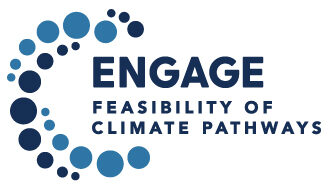Exploring The Outcomes And Consequences Of COP 26
February 1, 2022
In an online meeting on January 27th, the ENGAGE project and a broad group of stakeholders from across the world explored what happened at the UNFCCC Conference of Parties (COP26) in Glasgow and what this means for research.
Inspired by the opening comments made by a distinguished panel composed of representatives from the UNFCCC secretariat, the European Commission, Brazil, India and the USA, followed by two presentations from the ENGAGE project, the participants discussed the research needs and suggested the following priorities:
Research is required to support increasing the ambition of Nationally Determined Contributions (NDCs) and in particular to support the urgently needed implementation of proposed emissions reductions. This includes providing transparent and regularly updated tracking of how pledges (at the national and subnational levels) evolve over time (e.g., countries implementing or giving up on pledges). More research is needed on which countries and sectors are setting goals but not implementing them, and on other countries that may not have pledges yet but have been quite effective in reducing emissions in the short term.
- Regarding the global reporting and stock take, research can make an invaluable contribution in demonstrating how to make them forward-thinking and transformative.
- Considerable research is still needed in the area of finance, including collaborative financing mechanisms and determining the finance needs for developing countries.
- Research on climate change solutions should pay much more attention to social change and alternative forms of economy (e.g., sharing, degrowth, solidarity, Beyond GDP, green economy).
- Research must continue on the topics of equity, effort-sharing and environmental justice. What are the implications of these considerations for 2030? How can country pledges be reconciled with equity considerations and effort-sharing?
- There is an important need for better coverage of non-CO2 greenhouse gases in research.
- More research is needed to help some developing countries that hesitate to adopt low-carbon technologies, because they fear that these technologies may not perform, or because they do not have the required technical skills or the resources required. There is also the issue of employment, especially in developing countries, due to decarbonization of the power sector.
- From a modelling perspective: the NDCs needs to be consistent with long-term strategies. Models could be used to see whether there are policies that are less stringent until 2030 and then lead to faster emissions reductions. Is this feasible at the country level? A range of questions related to modelling require answers, e.g., How to capture technology-based mitigation solutions, for example, more biomass carbon capture and storage (CCS) and gas CCS and how models depict gas storage capability levels. How can models be used to carry out a reality check on what is represented in terms of updated costs and stability requirements? How can the demand system be changed and what is a feasible pace for energy demand reductions on a country level? How can differentiated governance levels be included in models?
The online meeting showed that research can play a very significant role over the next few years in shaping responses to climate change. Clear and transparent reporting of the results of scientific research will be needed and policy making must be informed in a holistic manner. This includes communication about the costs of inaction and clearly showing the repercussions of not sticking to the agreed goals. It will also be important to translate model results into more tangible near-term strategies that can better inform policy makers. The discussions also highlighted the continuing need for capacity building so that policy makers understand the research results, and so that scientists can respond more effectively to decision-makers’ and societal needs. Finally, it is essential to support developing countries through knowledge transfer, capacity building, research and development and building infrastructure.
A downloadable version of the above article is available on our Resources for Policymakers page.

